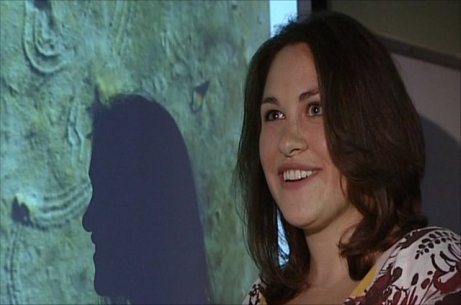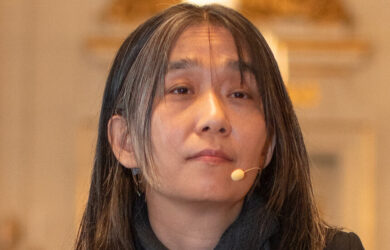
Jess Cooney's research will be presented at a conference this week.
Research into art made by young children in one of the most famous prehistoric decorated caves in France will be revealed by a Gates scholar at a conference this weekend.
Archaeologist Jess Cooney [2009] will tell a conference on the Archaeology of Childhood at Cambridge University how meticulous research, using methodology tailor-made for the task, has made it possible to identify both the age and gender of the children who made the simple art form known as finger flutings around 13,000 years ago during the hunter gatherer period.
Her work reveals that some of the flutings studied were made by a three-year-old child with the most prolific young artist being a girl of five. Archaeologists first realised that children had produced some of the finger flutings back in 2006: fieldwork carried out earlier this year by Cooney and Dr Leslie Van Gelder of Walden University, USA, shows just how young they were.
Each year thousands of people visit the caves at Rouffignac in the Dordogne region of western France, also known as the Cave of a Hundred Mammoths – to marvel at the extraordinary rock art: vivid images of animals drawn on the surfaces of the caverns deep inside a hillside.
However, the stunning drawings of mammoths, rhinoceros and horses represent just a small proportion of the art to be found within the 8 km cave system. Also evident are thousands of lines – a simple form of art or decoration known as finger flutings – made by people running their hands down the soft surfaces of the walls and roofs of the many galleries and passages that make up the complex.
Though impossible to date accurately, the images found deep inside the Rouffignac caves – a network created by river systems – are likely to be at least 13,000 years old. The caves themselves have been known since the 16thcentury; in 1575 François de Belleforestwrote about paintings in his book Cosmographie universelle. For centuries visitors to the caves added their own graffiti creating a frustrating puzzle for archaeologists.
It was not until 1956 that experts realised that some of the most striking art – including the images of animals – wasprehistoric. The drawings have been the subject of intensive study since. Only recently have archaeologists turned their attention to the less dramatic finger flutings, almost all of which are made without the application of pigment. Clues suggest that they date from the same time period as the painted and engraved animals – an era of hunter-gatherer culture known as the Magdalenian also responsible for the cave art at Lascaux.
At the conference Cooney will present the outcome of field work undertaken earlier this year when she and Van Gelder spent seven days carrying out detailed measurements in the Rouffignac caves. She will show how it is possible to determine not just the age and gender of the children who made the marks but also to identify individual children by their ‘signature’ marks. She will also raise broader questions such as what does it mean to be a child in prehistory, and whether age-based identities existed for much of humanity’s social evolution – in other words were children seen as we see them now?
“These are the kind of questions you ask yourself when you are deep underground in a cave looking at marks made many thousands of years ago lit by the beam of a flashlight,” said Cooney.
To carry out her investigations Cooney used a methodology developed by Van Gelder and the late Dr Kevin Sharpe, who together established the finger fluting research in Rouffignac Cave. Their hand research, statistically analysing thousands of hand widths from contemporary people, both children and adults, laid the foundations for the identification of individuals aged seven years or younger based on the width of the middle three fingers.
“By 2006 Sharpe and Van Gelder had developed a way of determining the age and gender of children’s hand impressions, through the flutings. As a methodology it’s amazingly accurate. By measuring the flutings at Rouffignac with callipers and matching them up against the modern data set we can tell the age of the child who made them to up to seven years old – and that is being conservative. Similarly, if we have a clear finger profile, the shape of the top edges of the fingers, we can tell to 80 percent accuracy whether the individual was female or male. This works with both children and adults. Using methodology we can also identify marks made by the same child,” said Cooney.
“Flutings made by children appear in every chamber throughout the caves even those that are a good 45 minutes’ walk from the entrance – so far, we haven’t found anywhere that adults fluted without children. Some of the children’s flutings are high up on the walls and on the ceilings, so they must have been held up to make them or have been sitting on someone’s shoulders. We have found marks by children aged between three- and seven-years-old – and we have been able to identify four individual children by matching up their marks.
“The most prolific of the children who made flutings was aged around five – and we are almost certain the child in question was a girl. Interestingly of the four children we know at least two are girls. One cavern is so rich in flutings made by children that it suggests it was a special space for them, but whether for play or ritual is impossible to tell.”
What is the significance of finger flutings – which also appear in other caves in France, Spain, New Guinea and Australia? “We don’t know why people made them. We can make guesses like they were for initiation rituals, for training of some kind, or simply something to do on a rainy day. In addition to the simple meandering lines, there are flutings of animals and shapes that appear to be very crude outlines of faces, almost cartoon-like in appearance. There are also hut-like shapes called tectiforms, markings thought to have a symbolic meaning which are only found in a very specific area of France. When in 2006 Sharpe and Van Gelder showed that that some of the tectiforms were the work of children, it was the first known instance of prehistoric children engaging in symbolic figure-making,” said Cooney.
Cooney is fascinated by the fact that children as young as three were active in the caves along with adults and that there appear to be few, if any, boundaries between adult activity and child activity. ‘What I wanted to do with my PhD was to allow prehistoric children to have a voice, since children are rarely talked about in academic discourse. What I’ve found in Rouffignac is that they are screaming to be heard – the presence of children is everywhere in the cave, even in the passages furthest from the entrance.”
Cooney is among presenters at the 5thAnnual Society for the Study of Childhood in the Past conference. The conference Child Labour in the Past: Children as economic contributors and consumers takes place at the University of Cambridge from 30 September to 2 October. http://www.sscip.org.uk/.












